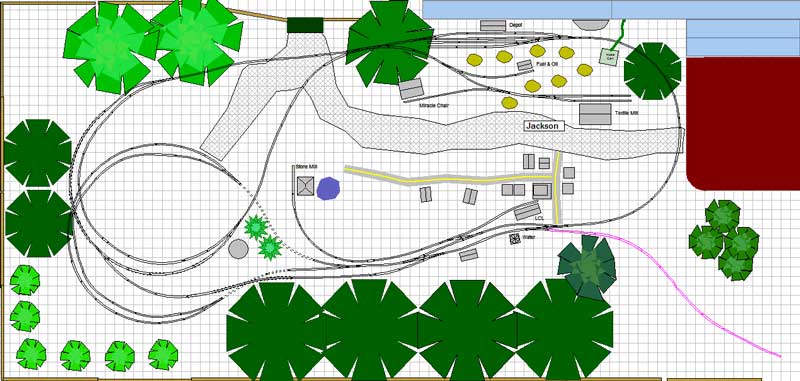As many of you know, I’ve been wanting to redesign my layout for operations. I think I’ve finally come up with a solution, and invite your comments and criticism. Operational Philosophy & Design Considerations on the J&B RR

The Railroad The track will consist of a folded loop to loop. A connector links the two loops for true continuous running without the need for throwing any switches.
There is one town, Jackson, which encompasses the right hand side. Originally, there were two towns, but the distance between them was so small, that it made sense to just make one town that extends around the “U”. The two loops will overlap each other at the far end of the yard, so the mainline makes a “U” across the rest of the lawn. Jackson will be the center of operations.
The purple line is for a possible logging line. Each loop has a passing siding that will also serve as a staging area.
The one obvious drawback is naturally the awkward construction of two loops that are different in height by at least a foot. It is possible to delay construction of the lower loop and just build the upper loop and connect it the lower side of the “U†. The loops will be used for staging trains so that they originate “offstage” and thus the yard requirements in Jackson are minimal since it will not be originating trains. The staging loops can become sources and destinations for off-road traffic. .
I have basically traded yard track for industrial sidings. There is some room to set out a diner or a sleeper on the two tracks near the depot. It is the main industrial area to be switched from trains originating elsewhere.
Jackson Jackson is served by a dedicated switcher and has many purposes:
- Home for the Shay, which makes daily trips to the woods for logs. For now, the logging mill will have to be offstage.
- A stop for bringing tourists north to the mountains, as well as mail and an express reefer.
- Home to assorted other industries like the Miracle Chair Company, a textile mill, a stone mill, and an LCL freight house.
Standards
- All switches will be #6.
- Code 250 rail.
- Minimum 10’ radius curves.
- All switches are hand thrown, so there MUST be room to stand near each switch.
- All cars are hand uncoupled, so there MUST be room to stand near each industry.
- Trains will be no longer than 6 cars plus a caboose.
Approach
- Use the loops for staging trains. Each loop has a passing siding to hold these trains.
- Trains originate elsewhere (imaginary towns not depicted, but represented by the loops) and no trains originate from my modeled town.
- Some sidings and industry exist along the main, outside of the main yard.
Passenger Operations Passenger Locomotives: #4 a 1:20 ten wheeler. One idea is to have it go one way in the morning, and return in the afternoon. The morning train could pick up the dining car on the way through the yard. It is then sent to a staging area. On its return, it could add a sleeper and continue to the next staging area. Or perhaps it picks up a diner and a parlor car.
Freight Operations Freight Locomotives: #2 Connie, #3 Shay Trains are staged ahead of time on the loops. As they enter town, the road locomotive could be detached for servicing and the switcher will take care of all local switching duties. It could do some of the “easy” switching in town. Industry Usage The following chart shows the type of car that can be used by each industry. Types that are not used may be used for through traffic.

Switching A boxcab will be the dedicated switcher for the town. It is based upon the Bachmann 45ton Diesel switcher. Many thanks to the people that have contributed ideas, but special thanks go to Doug Matheson for not only providing inspiration, but also design assistance.